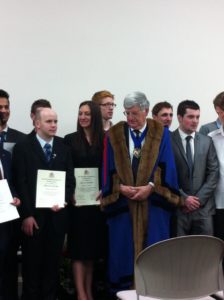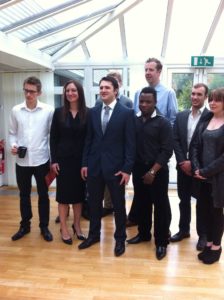POSTED ON
Particularly Engaging Students

For those readers who are keen listeners to BBC Radio then Robin Day’s World of Business is a must listen. I download them as podcasts and listen in the car while I drive up to the University from home. The programme this week was “Job Search: Millions of young people want to work but do not know where to find it”. The problem in much of the world seems to be that we are danger in losing a generation where the recession in the West is making it easier for companies to hold onto older workers than hiring young ones.
So when James Lang from the Scottish Leather Group can tell this year’s graduating students (they are still waiting for results at this time) that the employment rate for leather students over the last two years has been 100% you really wonder why the ranks of leather students in Northampton are not even fuller. Indeed it takes quite a special student in leather not to get a job.

Now that the leather industry and the University have really got to grips with the fact that leather just does not mean simply tanneries but takes into account everything from the farm to Facebook, the leather industry is a very exciting place with many skills and talents being exploited to support one great task – tanning fine leathers. The leather industry is now a real complex network with leather making at its heart and offers opportunities throughout the world in all types of organisations. James Lang talked about the work the industry does for the car business from Britain to Beijing, in airlines from BA to Qantas, in luxury goods from Burberry to LVMH, and in furnishing buildings from the Etihad Stadium to Parliaments around the world. All this before thinking about the 50% plus of all leather that goes into footwear, with Northampton itself being the world centre of excellence in premium men’s Goodyear Welted Footwear.
The temporary move out of London, while the new Leathersellers Hall is being built, has had a number of consequences which have not all been bad. We lose the grandeur and the chance to give students a full understanding of the historic importance of guilds, but we gain by a larger student attendance and a more flexible format. In the relaxed atmosphere of the Sunley Conference Centre more parents turned up than normal and we had the chance to add a visiting lecture by Japanese Professor Yuko Nishimura.
In the UK tanners have generally been highly thought of

Professor Nishimura is an anthropologist who has been studying the role of tanners in society over the centuries. She is fascinated by the fact that in the UK tanners have generally been highly thought of – she thinks this is related to the way in which our guilds evolved – compared to India and Japan where tanners are very low caste. In her lecture she dwelt on the Japanese History where tanners while being low caste still held great power in a huge variety of ways, from magic and mystery to dance and theatre. If a young lady discovered she had married a tanner by mistake, as one does, you could get a divorce at once. Tanners were also the Ninjas of ancient Japan. How cool.
The centre of Japanese Tanning is a town called Himeji and we were shown a film showing the traditional tanning process where the hides were being washed in the river. As the bacteria worked away at the hair roots the skins were quietly being alum tanned; as the river was high in aluminium coming from deposits upstream. A subsequent stamping with rape seed oil, which gives an aldehydic tanning effect, and a low cost, soft white leather is produced. It appears that a shrinkage temperature of about 65 degrees centigrade is achieved. The leather was used over 1000 years ago for making ceremonial soccer balls, and some more recently made were on show, and given to the ICLT.
We know that alum tanning goes back at least to the ancient Greeks, but was this the accidental way that the tanning effect of alum was first discovered?
Mike Redwood
7th May 2013